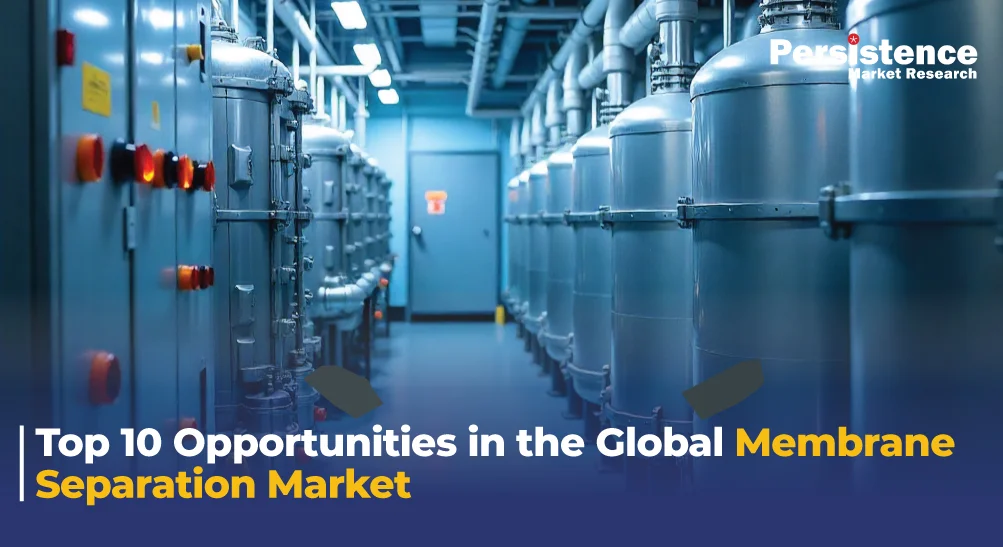- Blog
- Global Membrane Separation Market
Top 10 Opportunities in the Global Membrane Separation Market
Published On : 24 Oct 2025
The membrane separation market has evolved from a specialized segment into a core technology across water treatment, pharmaceuticals, food processing, energy, and chemical industries. Its growth is being shaped by mounting concerns over water scarcity, sustainability mandates, and the need for high-efficiency purification systems. Current estimates place the global membrane separation market in the tens of billions of dollars, with steady expansion expected through the next decade. This momentum reflects the technology’s increasing role in industrial efficiency, resource recovery, and clean energy development.

1. Municipal Desalination and Water Reuse Expansion
Large coastal and arid regions are turning to reverse osmosis (RO) and hybrid membrane systems as a cost-effective alternative to traditional desalination. Cities in the Middle East and Asia are investing heavily in RO-based facilities that combine pretreatment technologies to improve efficiency. These projects not only ensure long-term water security but also generate substantial demand for advanced membranes and integrated treatment systems.
2. Industrial Wastewater Recovery and Zero Liquid Discharge
Industrial sectors such as textiles, chemicals, and metal finishing are under increasing pressure to meet strict effluent discharge standards. Membrane-based systems like ultrafiltration (UF) and nanofiltration (NF) enable zero liquid discharge (ZLD) by separating valuable salts and recovering clean water for reuse. In India and China, several large-scale installations have demonstrated significant reductions in water consumption and chemical waste, signaling a broader shift toward circular water management.
3. Pharmaceutical Processing and Biomanufacturing
Biopharmaceutical production relies heavily on high-selectivity membranes for filtration, concentration, and purification. The growing market for biologics and vaccines has intensified demand for sterile and single-use membrane modules, which streamline validation processes and minimize contamination risks. Continuous bioprocessing systems, now gaining ground in advanced manufacturing facilities, further expand the role of membranes in drug production efficiency.
4. Hydrogen and Low-Carbon Fuel Applications
Membrane-based gas separation is increasingly used for hydrogen purification and carbon dioxide capture. Compared to pressure swing adsorption or cryogenic methods, polymeric and ceramic membranes offer lower capital cost and a smaller footprint in specific purity ranges. With major economies investing in hydrogen infrastructure, the demand for robust membranes capable of withstanding high temperatures and pressures is projected to rise sharply.
5. Decentralized Water Treatment for Remote Areas
Compact and modular membrane units are being deployed to address water challenges in rural and disaster-affected regions. Preassembled systems that integrate RO, UF, and membrane bioreactors (MBR) provide reliable purification with minimal technical supervision. In Africa and Southeast Asia, these modular installations are enhancing access to clean water where large infrastructure projects remain impractical.
6. Advancements in Membrane Materials and Coatings
The development of nanocomposite, graphene oxide, and fluoropolymer-based membranes represents one of the most dynamic areas of research. These materials offer superior chemical resistance, hydrophilicity, and anti-fouling performance, extending operational lifespans and reducing maintenance costs. Collaborations between chemical producers and research institutes are accelerating commercialization, giving rise to new categories of high-performance membranes for harsh environments.
7. Retrofitting and Energy Optimization of Existing Plants
Many older water treatment plants and industrial systems still operate with outdated membrane modules. Upgrading to modern, high-flux membranes or incorporating energy recovery devices can yield substantial efficiency gains. In Europe and North America, retrofit projects are gaining traction as utilities aim to lower operational costs and comply with new sustainability regulations.
8. Food and Beverage Process Enhancement
Membrane separation is increasingly used for concentration, clarification, and microbial stabilization in the food and beverage sector. In dairy processing, ultrafiltration and microfiltration replace traditional evaporation methods to produce high-protein ingredients with better flavor and nutrient retention. Breweries and beverage companies also employ membranes to achieve sterile filtration without heat treatment, preserving product quality while cutting energy use.
9. Digital Monitoring and Predictive Maintenance
The integration of digital twins and artificial intelligence into membrane systems is transforming plant operations. Data-driven monitoring enables predictive cleaning schedules, minimizes fouling, and optimizes energy use. These technologies are already being applied in municipal plants and industrial facilities, reducing downtime and chemical consumption through continuous system learning.
10. Aftermarket and Specialty Service Expansion
The replacement and refurbishment of membranes account for a significant share of the total market value. As membrane elements have defined operational lifespans, recurring demand for spare parts and maintenance services ensures long-term revenue stability for manufacturers. Niche markets such as electronics-grade water production and high-purity applications in semiconductor fabrication also create opportunities for specialized membrane solutions.
Market Landscape
The membrane separation market is characterized by a blend of global conglomerates and specialized technology developers. Leading companies such as Toray Industries, Nitto Denko (Hydranautics), DuPont, Koch Separation Solutions, SUEZ Water Technologies, and Asahi Kasei hold significant shares. Emerging players are focusing on ceramic membranes, bio-based polymers, and smart monitoring platforms to differentiate themselves in a competitive environment.
Conclusion
The membrane separation industry is becoming integral to the global shift toward sustainability, efficient resource management, and cleaner industrial operations. From large-scale desalination to high-purity pharmaceutical processing, membranes are redefining how water, chemicals, and gases are purified and reused. Continuous innovations in materials, digital monitoring, and decentralized treatment systems are expanding the market’s reach. The next decade is expected to consolidate membranes’ position as a core enabler of industrial and environmental transformation, linking technological progress directly with global sustainability goals.
Industry Report

Request Report Sample
Your privacy is important to us; your data is secure
Contact Us
Latest Reports
-
Hemoglobinopathy Market by Diagnostic Test (Routine Red Blood Cell (RBC) Count, Genetic Testing, Hemoglobin by High Performance Liquid Chromatography, Hemoglobin Isoelectric Focusing (Hb IEF), Hemoglobin Electrophoresis (Hb ELP), Hemoglobin Solubility Test), Indication, End-user, and Regional Analysis from 2026 - 2033
-
Thermal Ablation Devices Market by Product (Systems, Probes), Technology (Radiofrequency Ablation, Hydrothermal Ablation, Microwave Ablation, Laser Ablation, Ultrasound Ablation), End-user, and Regional Analysis from 2026 - 2033
-
Ventilator Test Systems Market by Ventilator Type (Critical Care Ventilators, Neonatal Ventilators, Transport & Portable Ventilators), by Product Type (Desktop / Benchtop, Portable), by End-user, and Regional Analysis from 2026 - 2033
-
Buckwheat Market by Form (Groats, Flour, Flakes, Others), Route of Administration (Oral, Parenteral, Topical), Nature, End-user, and Regional Analysis from 2026 - 2033
-
Aesthetic Lasers and Energy Devices Market by Product (Laser Devices, Radiofrequency Devices, Intense Pulsed Light (IPL) Devices, Ultrasound Devices, and Others), by Application (Body Contouring, Laser Hair Removal, Skin Tightening, Skin Rejuvenation, and Others) by End-user (Hospitals, Aesthetic Clinics, Spa and Salon, and Home Care Settings), and Regional Analysis from 2026 - 2033
